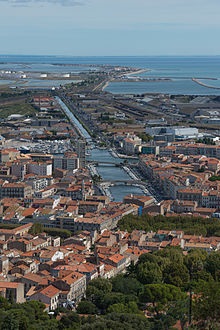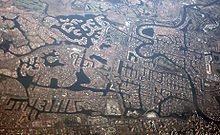|
|
| |
|
|
| |
|
|
|
|
| |
 |
| Canal in Sète,
France. |
Canals
Canals are waterways, channels, or artificial waterways,
for water conveyance, or to service water transport
vehicles. They may also help with irrigation. It can be
thought of as an artificial version of a river. Canals
carry free surface flow under atmospheric pressure.
In most cases, the engineered works will have a series
of dams and locks that create reservoirs of low speed
current flow. These reservoirs are referred to as slack
water levels, often just called levels.
A canal is also known as a navigation when it parallels
a river and shares part of its waters and drainage
basin, and leverages its resources by building dams and
locks to increase and lengthen its stretches of slack
water levels while staying in its valley.
In contrast, a canal cuts across a drainage divide atop
a ridge, generally requiring an external water source
above the highest elevation.
Many canals have been built at elevations towering over
valleys and other water ways crossing far below.
Canals with sources of water at a higher level can
deliver water to a destination such as a city where
water is needed. The Roman Empire's aqueducts were such
water supply canals. |
|
 |
| Aerial view of the
man-made canals of the Gold Coast, Queensland,
Australia. |
Types of artificial
waterways
Saimaa Canal, a transportation canal between Finland and
Russia, in Lappeenranta
A navigation is a series of channels that run roughly
parallel to the valley and stream bed of an unimproved
river. A navigation always shares the drainage basin of
the river. A vessel uses the calm parts of the river
itself as well as improvements, traversing the same
changes in height.
A true canal is a channel that cuts across a drainage
divide, making a navigable channel connecting two
different drainage basins.
Most commercially important canals of the first half of
the 19th century were a little of each, using rivers in
long stretches, and divide crossing canals in others.
This is true for many canals still in use. Canals are an
efficient way of traveling as it was easier for people
to get to areas faster than horse wagons. |
|
Structures used in
artificial waterways
Both navigations and canals use engineered structures to
improve navigation: |
- weirs and dams to raise river water
levels to usable depths;
- looping descents to create a longer
and gentler channel around a stretch of rapids or falls;
- locks to allow ships and barges to
ascend/descend.
|
|
Since they cut across drainage divides, canals are more
difficult to construct and often need additional
improvements, like viaducts and aqueducts to bridge waters
over streams and roads, and ways to keep water in the
channel. |
|
Types of canals
There are two broad types of canal: |
- Waterways: canals and
navigations used for carrying vessels transporting
goods and people. These can be subdivided into two
kinds:
- Those connecting existing lakes,
rivers, other canals or seas and oceans.
- Those connected in a city
network: such as the Canal Grande and others of
Venice; the grachten of Amsterdam or Utrecht, and
the waterways of Bangkok.
- Aqueducts: water supply canals
that are used for the conveyance and delivery of
potable water for human consumption, municipal uses,
hydro power canals and agriculture irrigation.
|
 Kiddle: Canals Kiddle: Canals
Wikipedia: Canals |
|
|
|
|
|
|
|
|
|
|
|
|
|
|
|
|
|
|
Search Fun Easy English |
|
|
|
|
|
|
|
|
|
|
|
|
|
|
|
About
Contact
Copyright
Resources
Site Map |